Lynar Tablatures: Difference between revisions
Fiskfan1999 (talk | contribs) No edit summary |
Fiskfan1999 (talk | contribs) →Lynar A 1: start contents of lynar a 1 |
||
| Line 43: | Line 43: | ||
Actually, the scribe of the manuscript is not [[Matthias Weckmann]] (like [[Max Seiffert]] said)<ref>Schierning, 78</ref><ref>Dirksen, 21</ref>. | Actually, the scribe of the manuscript is not [[Matthias Weckmann]] (like [[Max Seiffert]] said)<ref>Schierning, 78</ref><ref>Dirksen, 21</ref>. | ||
==== Contents ==== | |||
{| class="wikitable" | |||
|+ Contents of [[D-B Ms. Lynar A 1]] | |||
|- | |||
! Pages !! Title !! Incipit !! Notes !! Ref. | |||
|- | |||
| 1-5 || Toccata /<br>Joan Peters || <score><< \relative e' { \time 4/2 \clef alto e2. f4 g2~g8 a f g } \\ \relative c { c1 c2 b } \\ \relative c' { c2. d4 e2 d } \\ \relative g { g1 g } >></score> || || | |||
|- | |||
| 6-9 || Toccata 2di /<br>Toni /<br>Joann Peters || <score><< \relative g' { \clef alto \key f \major \time 4/2 <g d bes >1 4 f8 e d c bes a } \\ \relative g { <g g,>1 1 } >></score> || || | |||
|- | |||
| 10-13 || Toccata 2di /<br>Toni /<br> Johann: Peters. || <score><< \relative g' { \time 4/2 \clef alto \key f \major g1 g a4.*4/3 } \\ \relative g { g2. a4 bes2 a4 g d'1*1/2 } >></score> || || | |||
|- | |||
|14-15 || Toccata. 2di /<br>Toni. /<br>Joan Peters || <score><< \relative g' { \clef alto \time 4/2 \key f \major g1 g4. fis8 g4 a } \\ \relative g { g1 g } \\ \relative d' { d1 d } \\ \relative bes { bes1 bes4. a8 bes4 c } >></score> || Incomplete || | |||
|- | |||
| 18-21 || Toccata Primi /<br>Toni. /<br>Joann Peters. || <score><< \relative d' { \clef alto \time 4/2 d2. e4 f g a2\laissezVibrer } \\ \relative d { r2 d1 c2 } \\ \relative a { r1 a2. a4 } >></score> || || | |||
|- | |||
| 22-26 || Toccata /<br>9 Toni /<br>Joan Peters || <score><< \relative a' { <a c e>1 1 } \\ \relative a, { \time 4/2 a1 a' } \\ \relative a { a2. b4 c4. b8 a b c d } >></score> || || | |||
|- | |||
| 27-34 || Tocata /<br>J. P. S /<br>Noni toni || <score><< \relative a' { \time 4/2 \clef alto <a e c>4. e8 f g a b c[ a e' d] } \\ \relative a { <a e a,>1 1*1/4 } >></score> || || | |||
|- | |||
| 35-38 || Fantasia /<br>primi Toni /<br>A.4. /<br>C. E || <score>\relative a' { \time 4/2 a1 a2 a f4 d }</score> || || | |||
|- | |||
| 38-40 || Fuga Secundi /<br>Toni /<br>C. E || <score>\relative g { \clef alto \key f \major \time 4/2 g4 d g a bes g bes c }</score> || || | |||
|- | |||
| 41-42 || Fantasia /<br>3tij Toni || <score>\relative e { \clef bass \time 4/2 e2 e4 e a8 b c a b c d b }</score> || || | |||
|- | |||
| 42-43 || Fantasia /<br>Quarti /<br>Toni /<br>Giuon Gabrielis || <score><< \relative b { \clef bass \time 4/2 b1 b2 b a b g a } \\ \relative e { R\breve r1 e } >></score> || || | |||
|- | |||
| 44-46 || Tocata Quintij /<br>Toni || <score><< \relative g' { \time 4/2 \clef alto g1 g2 c } \\ \relative c { <c e g>1~ 2 2 } \\ \relative c' { c2. d4 e d e f } >></score> || || | |||
|- | |||
| 47-49 || Fantasia /<br>sexti Toni || <score><< \relative c'' { \time 4/2 \key f \major c1 f1~2 e d c }\\ \relative f' { r1 r2 f bes1~2 a } >></score> || || | |||
|- | |||
| 50-53 || Ricercar /<br>7mj et 8ui /<br>toni || <score>\relative g' { \time 4/2 g1 d'2. d4 d2 d c a }</score> || || | |||
|- | |||
| 53-55 || Fuga g.mi /<br>Toni || <score>\relative e'' { \time 4/2 e1 e2 e a,4 a' e f }</score> || || | |||
|- | |||
| 56-63 || Fantasia Crom.. /<br>matica /<br>A.4. /<br>Johanpietersen /<br>Swellinck || <score>\relative d' { \clef alto \time 4/2 d1 d2 2 cis c b bes }</score> || || | |||
|- | |||
| 64- || Riecercar /<br>10mi Toni || <score>\relative a { \time 4/2 a1 a2 a c1 b2 g }</score> || || | |||
|- | |||
| || || || || | |||
|- | |||
| || || || || | |||
|- | |||
| || || || || | |||
|- | |||
| || || || || | |||
|} | |||
==== References ==== | ==== References ==== | ||
Revision as of 12:23, 29 December 2023
The Lynar tablatures are a collection of manuscripts that are currently held in the Staatsbibliothek, Berlin. It has been interpreted as one of the most important sources for the works of the North-German pupils of Jan Pieterszoon Sweelinck.
With a few exceptions, the Lynar Tablatures exclusively transmit keyboard music, mostly for organ. The exceptions are one manuscript which appears to contain an Intabulation of a cantata (see B 10) and another which appears to be transcribed from a psalm part book (C).
All of the Lynar Tablatures except B 2 and C 1 are already digitized. However, it appears that B 2 is currently being digitized[as of September, 2023][1].
History[2]
The first Lynar tablatures that were known to musicologists were the A 1 and A 2 manuscripts. These two manuscripts had copies made of them in the middle of the 19th century. Later in the 19th century both manuscripts went missing (In the 1894 edition of keyboard works of Sweelinck, Max Seiffert could only rely on the 1841 copy). However, the "A" manuscripts were fortunately found in 1920, and around this time the 11 manuscripts in tablature notation were discovered by Rochus Friedrich zu Lynar. All 13 manuscripts were collected and stored in the Spreewald museum in Lübbenau-Lehde. In 1933[3] Max Seiffert inspected the manuscripts and assigned the shelfmarks starting with A (referring to staff notation) and B (tablature notation). The description penciled on the front of each manuscript is written by Seiffert.
In 1956, the manuscripts were moved to the Staadtsbibliothek, Berlin, retaining their previous shelfmarks.
Description
According to the Berlin Staatsbibliothek website, the shelfmark for the manuscripts is stylized Ms. Lynar A 1, Ms. Lynar B 2, etc.
Analysis
Pieter Dirksen[4]
The Lynar B tablatures as a whole must now be seen as a closely connected series of sources which probably actually originated within the North German Sweelinck school, going back directly to one of the North German Sweelinck pupils.[5]
The Lynar B tablatures have proven valuable as a source of works from the North-German Sweelinck school as well as from Sweelinck himself, as thirteen works (including 10 not known from any other source) by him are found within.
Dirksen interprets the 11 "B" tablatures as forming a unified whole because (among other reasons) it can be identified that some of the unknown copyists wrote more than one manuscript each.
As for the originating location of the manuscripts, the area of Gdańsk (german: Danzig) was theorized based on the inclusion of pieces by Paul Siefert and Andreas Neunhaber. Similarly based on circumstantial evidence, the manuscripts can be dated to around the 1620s (even though some pieces within can be dated to later). One date found within the manuscript, 1628, also suggests this.
Dirksen notes that the works by Sweelinck must have been transcribed from Anglo-Dutch staff notation to New German Tablature Notation.
References
Schierning, Lydia. Die Überlieferung der deutschen Orgel- und Klaviermusik aus der esten Hälfte des 17. Jahrhunderts: Eine quellenkundliche Studie. Kassel: Bärenreiter, 1961.
- ↑ stabikat.de, accessed 24 September, 2023. -> "Online-Zugang": Das Werk, das Sie suchen, befindet sich aktuell in der Digitalisierung.
- ↑ Schnieders, Hans, "Fingersätze für Tasteninstrumente aus dem Umfeld Sweelincks und seiner Schüler". [1], accessed 15 September, 2023. 2.15 Lynar A1
- ↑ Seiffert, Max (editor), Sweelinck: Werken voor Orgel en Clavecimbel. Amsterdam: G. Alsbach & Co., 1942. xlvi
- ↑ Dirksen, Pieter. Heinrich Scheidemann's Keyboard Music: Transmission, Style and Chronology. Aldershot: Ashgate, 2007. 9-10.
- ↑ Dirksen, Pieter (editor). Psalm Variations from Lynar B 7. Exempla Musica Neerlandica XVIII. Utrecht: Koninklijke Vereniging voor Nederlandse Muziekgeschiedenis, 1996. VIII
Contents
Lynar A 1
Seiffert: Ms. Lynar A 1 | Jugendautograph des Hamburger | Organisten Matthias Weckmann | (1620-1674), begonnen 1637 in Ham- | burg. Niederländische Tabulatur auf | 2 x 6 Linien. | Inhalt Kompositionen von | Jan Pieters Sweelinck, Christian | Erbach, Gio. Gabrieli, Peter Philipps, | John Bull, Gilles Farnaby, L. Wood- | sen, La Barre, Gautier, Ballard, | M. Weckmann, Pieter Cornet.
Ms. Lynar A 1: Young autograph by the Hamburg organist Matthias Weckmann (1620-1674), begun in 1637 in Hamburg. Dutch tablature on 2x6 lines. ...
D-B Ms. Lynar A 1 Online facsimile: digital.staatsbibliothek-berlin.de accessed 15 December, 2023.

Ms. Lynar A 1 is a manuscript in Dutch 6-line staff notation. It contains 81 keyboard pieces.
Lynar A 1 is one of the first manuscripts to be known to early musicologists. Despite going missing in the late 19th century, it has been rediscovered.
Actually, the scribe of the manuscript is not Matthias Weckmann (like Max Seiffert said)[1][2].
Contents
| Pages | Title | Incipit | Notes | Ref. |
|---|---|---|---|---|
| 1-5 | Toccata / Joan Peters |
 |
||
| 6-9 | Toccata 2di / Toni / Joann Peters |
 |
||
| 10-13 | Toccata 2di / Toni / Johann: Peters. |
 |
||
| 14-15 | Toccata. 2di / Toni. / Joan Peters |
 |
Incomplete | |
| 18-21 | Toccata Primi / Toni. / Joann Peters. |
 |
||
| 22-26 | Toccata / 9 Toni / Joan Peters |
 |
||
| 27-34 | Tocata / J. P. S / Noni toni |
![<< \relative a' { \time 4/2 \clef alto <a e c>4. e8 f g a b c[ a e' d] } \\ \relative a { <a e a,>1 1*1/4 } >>](/wiki/images/lilypond/e/t/etb445gie3oiin3okb63d8yeh058aq3/etb445gi.png) |
||
| 35-38 | Fantasia / primi Toni / A.4. / C. E |
 |
||
| 38-40 | Fuga Secundi / Toni / C. E |
|||
| 41-42 | Fantasia / 3tij Toni |
 |
||
| 42-43 | Fantasia / Quarti / Toni / Giuon Gabrielis |
 |
||
| 44-46 | Tocata Quintij / Toni |
 |
||
| 47-49 | Fantasia / sexti Toni |
 |
||
| 50-53 | Ricercar / 7mj et 8ui / toni |
 |
||
| 53-55 | Fuga g.mi / Toni |
 |
||
| 56-63 | Fantasia Crom.. / matica / A.4. / Johanpietersen / Swellinck |
|||
| 64- | Riecercar / 10mi Toni |
 |
||
References
Schierning, 66-81
Dirksen, Pieter. Heinrich Scheidemann's Keyboard Music: Transmission, Style and Chronology. Aldershot: Ashgate, 2007. 20-22, 656-658
Lynar A 2
Seiffert: Italienisch-niederländische Tabulatur eines | süddeutschen Schreibers um 1610; 2 Systeme | 6 + 7 und 6 + 6 Linien. | Enthält Kompositionen von | Christian Erbach und der Engländer Will. | Byrd, Dr. Bull, Orlando Gibbons, | sowie einige von Gio. Gabrieli und Tarq. | Merula.
Italian-Dutch tablature from south-German scribes from 1610; 2 systems, 6+7 and 6+6 lines. ...
D-B Ms. Lynar A 2 Online facsimile: digital.staatsbibliothek-berlin.de accessed 15 December, 2023.
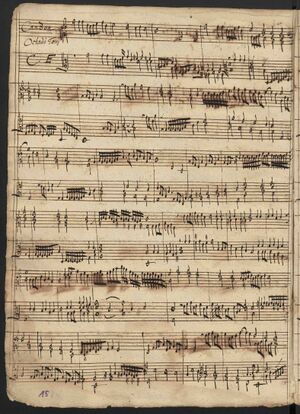
References
Lynar B 1
Seiffert: Ms. Lynar B 1 | Deutsche Orgeltabulatur vom 1. Drittel | des 17. Jhdt. | Enthält Kompositionen von | J. P. Sweelinck, Paul Siefert, | Andr. Düben, Jak.Prätorius, Peter | Hasse, Gottfr. Scheidt, Samuel Scheidt | W. Karges, D. H. und M. D.
Ms. Lynar B 1; German tablature from the first 3rd of the 17th century. Contains compositions frome Jan Pieterszoon Sweelinck, Paul Siefert, Andreas Düben, Jacob Praetorius, Peter Hasse, Gottfried Scheidt, Samuel Scheidt, Wilhelm Karges, D. H. and M. D.
D-B Ms. Lynar B 1 Online facsimile: digital.staatsbibliothek-berlin.de accessed 3 November, 2023.
Ms. Lynar B 1 contains 71 pages. Among other things, it contains a compilation of settings of Allein Gott in der Höh sey Ehr by different composers.
| No. | Title | notes |
|---|---|---|
| 1 | Fantasia Auff die manier von ein Echo. M. J. P. S. | Jan Pieterszoon Sweelinck |
| 2 | Puer natusin Bethlehem a Paulus Sivert | Paul Siefert |
| 3 | Nun komm der Heÿden Heÿlandt | Paul Siefert? |
| 4 | Nun Lobe meine Seele den Herren Auff 2 Clavir D. H. | Düben? |
| 5 | Wo Gott der Herr nicht beÿ unß Held auff 2 Clavir Andræ Duben | Andreas Düben |
| 6 | Allein Gott inn der Höh seÿ Ehr. M. J. P. | Jan Pieterszoon Sweelinck |
| 7 | Variatio Bicinium M. J. P. | Jan Pieterszoon Sweelinck |
| 8 | Variatio coral in Tenor M. J. P. | Jan Pieterszoon Sweelinck |
| 9 | Variatio coral in cantu 4 Vocum M. J. P. | Jan Pieterszoon Sweelinck |
| 10 | Variatio Choral in Cantu auff 2 Clavier A. Duben | Andreas Düben |
| 11 | Variatio choral in Basso A. D. | Andreas Düben |
| 12 | Variatio Choral in Bass M. Duben | Martin Düben |
| 13 | Variatio Choral in Baß 3 vocum | |
| 14 | Varatio | |
| 15 | Variatio Choral in Tenore 3 vocum P Hassen | Petrus Hasse |
| 16 | Variatio 3 Vocum Choral in Basso P. Hass | Petrus Hasse |
| 17 | Var. 12 G. S. | Gottfried Scheidt |
| 18 | Var. Choral in Cantu auff 2 Clav. G. S. | Gottfried Scheidt |
| 19 | 4 vocum | |
| 20 | Variatio Zum Alt vndt Tenor muße nur Stimmen von 4 Fuß gezogen werden | |
| 21 | Variatio Choral in Cantu auf 2 Clav. | |
| 22 | Variatio Choral in Tenore | |
| 23 | Allein Gott in der Höh seÿ EHR: S. S. | Samuel Scheidt |
| 24 | Allein Gott â 3 Vocum Choral in Bass W. Karges | Wilhelm Karges |
| 25 | Erstanden ist der Heilige Christ M. D. Simpel - Auff 2. Clavir - Choral in Cantu auff 2. Clavier. - Coral in Basso 3. Voc: | Martin Düben |
Analysis
Allein Gott in der Höh sei Ehr
One of the striking features of this manuscript is a cycle of chorale settings of Allein Gott in der Höh sei Ehr (with continually incrementing variation number), with some attributed to different composers and others left anonymous.
Theories have surrounded the reasoning for these compositions to have been included together. Max Seiffert said that they could have been composed by Sweelinck and his pupils together as one complete work. However, this was rejected by Margarete Reimann, who said that it was simply compiled by someone else, perhaps the scribe of Ms. Lynar B 1. However, Pieter Dirksen states that the true facts may not be so simple. For instance, many of the variations form strong variation cycles themselves, such as the first few variations by Sweelinck. After these, the rest are more reminiscent of contrapuntal excercises, but several of the anonymous variations have stylistic similarities with each other, and it is possible that they were composed by the same person.
It was noted that variation 15 is a transposed copy of variation 7 (this was pointed out by Gisela Gerdes.
References
Dirksen, Pieter (editor). Orgelmusik av familjen Düben. Stockholm: Runa Nototext, 1996. xxi-xxii.
Beckmann, Klaus, Die Norddeutsche Schule. Teil II: Blütezeit und Verfall. Mainz: Schott, 2009.
Schierning, 32-34
Lynar B 2
Seiffert: Ms. Lynar B 2 | Deutsche Orgeltabulatur ca. 1630 | Darin genannt Melchior Schildt | und J. P. Sweelinck, sonst alles anonyme Stücke
Ms. Lynar B 2; German organ tablature from around 1630. Within it are pieces by Melchior Schildt and Jan Pieterszoon Sweelinck, the rest anonymous.
Description
Lynar B 2 is a folio volume over 30 pages.
It doesn't contain any clues as to its origin, copyist, or date. Some theories include that it was compiled in North Germany around 1620-1630 or by Melchior Schildt while he was in Copenhagen around 1626-1629. However, different hands can be identified as having copied different pieces in the manuscript, so it may have been compiled over a longer period of time.
The tablature contains only fantasias and chorale/psalm settings. Of the 17 pieces contained within, two are headed by initials which give a hint to the composer. Of the rest, three more can be identified based on concordances with other manuscripts. The composers of these five works are Jan Pieterszoon Sweelinck, Melchior Schildt and Heinrich Scheidemann. The rest of these pieces remain anonymous, but can be attributed to various composers on stylistic grounds.
Works
| No. | Title | notes | Incipit | Ref. |
|---|---|---|---|---|
| 1 | [Fanta]sia [mit B]indungen | Jan Pieterszoon Sweelinck | ||
| 2 | Fantasia A 4 | Anonymus: Jan Pieterszoon Sweelinck | ||
| 3 | fantasia primi Toni A 4 | Nun komm der Heiden Heiland |  |
[1] |
| 4 | ach Gott vom him: mel sieh darein. | Heinrich Scheidemann? |  |
[1] |
| 5 | Herr Christ der Einig Gottes Sohn… M.S | Melchior Schildt | ||
| 6 | Wie schön leucht unß der Morgenstern | 1 variation 2 variatio  3 variatio  4 variatio  5 variatio  |
[1] | |
| 7 | Nun freut euch lieben Christen gmein | 1 variatio 2 variatio 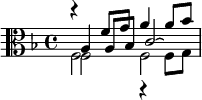 3 variatio 4 variatio  5 variatio  |
[1] | |
| 8 | psalm 116 J. P. | Jan Pieterszoon Sweelinck | ||
| 9 | O Lux Beata Trinitas: |  |
[1] | |
| 10 | psalm 60 A 2 | Anonymus: Jan Pieterszoon Sweelinck | ||
| 11 | O Gott du unser Vater bist | Anonymus: Jan Pieterszoon Sweelinck | 1 variatio 2 variatio 3 variatio  |
[1] |
| 12 | P 23 Mein hütter Undt mein hirtt | Anonymus: Jan Pieterszoon Sweelinck |  |
[1] |
| 13 | die 10 Gebott Gottes | Jan Pieterszoon Sweelinck | 1 variatio 2 variatio  3 variatio  4 variatio  |
[1] |
| 14 | Es spricht den unweisen Mundt woll | Heinrich Scheidemann | ||
| 15 | Fuga Cromatico ex D.la.sol.re. | |||
| 16 | Fantasia A. 2: 3: et 4 Vocum | Anonymus: Jan Pieterszoon Sweelinck | ||
| 17 | Fantasia Super ut re mi fa.sol.la. A. 3. Vocum |
After the publishing of 8 more works in Lynar B 2 by Pieter Dirksen in 1991, two works remain unpublished. The Fuga Cromatico and Fantasia Super ut re mi fa.sol.la. were described as "a brief composition employing imitation and simple chromatic lines" and "a pedantic, three-part hexachordal settings, in which the sogetto appears in the bass thirteen times in exactly the same form, constantly alternating between entries on c and G" respectively.
The setting of O God die onse Vader bist can for now be securely attributed to Sweelinck on the basis of the cantus firmus being a Dutch psalm in addition to stylistic features. Similarly, the setting of Psalm 23 can also be attributed to him, especially based on the similarities to Sweelinck's composition on Psalm 116 (which can be found in other manuscripts).
Confusingly, the manuscript contains a piece titled "fantasia primi / Toni A 4" which is neither a fantasia nor in the first tone. In fact, it is a chorale setting of Nun komm, der Heiden Heiland.

It is possible that this heading was written by a different copyist before this work was written at a later date. In any case, this work only uses the first (identical with the last) line of the chorale (which means that this work could be classified as a choral ricercare or choral fugue), and the contrapuntal writing is strikingly plain and schematic. In fact, this piece has been described as containing a "peculiar monothematic compositional technique, which is probably unparalleled in the surviving corpus of seventeenth century choral settings."
According to Pieter Dirksen, the chorale fantasia Ach Gott, vom Himmel sieh' darein stands apart from the other works in Lynar B 2, as it transmits a chorale fantasia in the fully mature form. This piece can be attributed to Heinrich Scheidemann based on a few factors, including the absence of so-called "simple echo combinations". It can be dated from around 1640-1650.
The setting of O Lux beata Trinitas appears to be a result of the early Sweelinck school based on some sixteenth-note figurations that can be found within it. However, it can not be found to be similar to any single composer on stylistic grounds. The cantus firmus appears in the tenor voice completely un-ornamented in long notes. This arrangement suggests that it can be played in pedal, but the voice rises up to f' which would require a 4-foot stop to be used on an organ with a 27-note pedalboard.
References
Beckmann, Klaus, Die Norddeutsche Schule. Teil II: Blütezeit und Verfall. Mainz: Schott, 2009.
Dirksen, P., "Eight Chorale Settings by Jan P. Sweelinck and his School", 1991, Vereniging voor Nederlandse Muziekgeschiedenis, Utrecht<
Schierning, 32-34
Lynar B 3
Seiffert: Ms. Lynar B 3 | Deutsche Orgeltabulatur ca. 1630 | Genannt sind darin: H. Scheide- | mann, J. P. Sweelinck, David Abel, | Andr. Düben, M. D., Peter Hasse, | M. W. C. B. M.
Ms. Lynar B 3. German organ tablature from around 1630. Contains: Heinrich Scheidemann, Jan Pieterszoon Sweelinck, David Abel, Andreas Düben, M. D., Peter Hasse, M. W. C. B. M.
D-B Ms. Lynar B 3 Online facsimile: digital.staatsbibliothek-berlin.de accessed 3 November, 2023, mirrored IMSLP554336.
The numbers are penciled in by a librarian (on the bottom right).
| fol. | Title | Incipit | Notes | Ref. |
|---|---|---|---|---|
| 1r | [missing] | Title is on missing verso side | ||
| 1r | Praeludium | Piece continues on missing verso side. | ||
| 1v-2r | Praludium | |||
| 2v-3r | Praludium | |||
| 3v-4r | Praludium | |||
| 4v-5r | Praludium / H S M |
|||
| 5v-6r | Vater unser in Himmell / reich. / MW. C. B. M. |
[1] 2 Variation 3 |
||
| 6v-9r | Fantasia / J. P. |
|||
| 9v-10r | Fantasia. / 6 toni. |
|||
| 10v-11r | Praludium / pedaliter |
|||
| 11v-12r | Herr Christ / der einige Got / tes Sohn. |
|||
| 12v-12ar | Praludium | |||
| 12av-13v | Praludium | |||
| 13v-14r | Praludium | |||
| 14v-15r | Praludium / secundi Toni / Auf 2 Clavir / und pedale. |
|||
| 15v-18r | Fantasia | |||
| 18v-20r | Vater unser in himmell / reich Corahll / in Bas. |
[1] 2 Vers auf / zwei Clavier / und Pedahll. |
Actually by Heinrich Scheidemann | |
| 20v-21r | O Mensch Be,, / weine deine / sünde gros auf. / 2 Clavier der Co,, / rahll gecolorirett / M. W. C. B. M. |
|||
| [23]v-24r | Praeludium / pedaliter / David Abel. |
|||
| 24v-25r | Praludium / David Abels. |
|||
| 25v-26r | Fuga | |||
| 26v-27r | Ricercar / primi Toni |
|||
| 27v-30r | Ricercar / primi Toni / ex G.B.moll |
|||
| 30v-31r | Praludium / Ex E. Vel/ a. pedaliter / A. D. O. |
|||
| 31v-32r | Praambulum / pedaliter / M. D. O. |
|||
| 32v-33r | Praambulum / pedaliter |
|||
| 33v-34r | Praambulum / pedaliter |
|||
| 34v-35r | Praambulum / pedaliter / P. H. |
|||
| 35v-36r | Praludium / pedaliter / M. F. P. S. W. |
|||
| 36v-37r | Praludium / Pedaliter |
|||
| 37v-38r | Praludium / M. D. O |
|||
| 38v-39r | Praludium / pedaliter |
|||
| 38v-39r | Praludium | |||
| 38v-39r | Praludium / pedaliter |
|||
| 38v-39r | Praludium / pedaliter |
|||
| 39v- | Praludium / pedaliter |
Fragment |
References
- ↑ digital.staatsbibliothek-berlin.de, online scan.
Lynar B 4
Seiffert: Ms. Lynar B 4 | Deutsche Orgeltabulatur ca. 1630. | Genannt nur J. P. Sweelinck, | sonst anonyme Stücke.
Ms. Lynar B 4. German organ tablature from around 1630. Containing pieces by only Jan Pieterszoon Sweelinck, the rest anonymous.
D-B Ms. Lynar B 4 Online facsimile: digital.staatsbibliothek-berlin.de accessed 3 November, 2023.
This manuscript contains four pieces:
- "In dir hab / ich gehoffet / Herr / auf 2 Clavier / manualiter" starting on page 1
- Illegible, maybe "Jesus Christus / unser heÿlantt / auf 2 Clavir / pedaliter" on page 4
- "Fantasia / M. S[?]. P." on page 10
- "Fantasia / A. 3 Vocum / Transpon: per 4ton" starting on page 14 and ending on the page 16-17 opening.
The page numbers (instead of folios) have been penciled in by a librarian.
References
Lynar B 5
Seiffert: Ms. Lynar B 5 | Deutsche Orgeltabulatur ca. 1630 | Darin 1 Choralbearbeitung von | Jakob Praetorius (unvollständig)
Ms. Lynar B 5. German organ tablature from around 1630. Contains one choral work from Jacob Praetorius (incomplete).
D-B Ms. Lynar B 5 Online facsimile: digital.staatsbibliothek-berlin.de accessed 3 November, 2023.
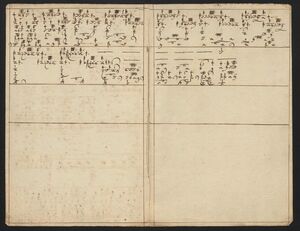
This manuscript contains one piece, a fragment of a Chorale Fantasia Durch Adams Fall ist ganz verderbt auff 3 clavier by Jakob Praetorius. The piece is neatly written in five voices, suggesting that the top voice is to be played on Rückpositiv, the second on Brustwerk, the third and fourth on Organum, and the bottom in Pedal[1].
References
- ↑ Brieg, Werner (editor). Jacob Praetorius: Choralbearbeitunen für Orgel. Kassel: Bärenreiter, 1974.
Lynar B 6
Seiffert: Ms. Lynar B 6 | Deutsche Orgeltabulatur ca. 1630 | Enthält 1 Toccata von Heinrich | Scheidemann
Ms. Lynar B 6. German organ tablature from around 1630. Contains one toccata by Heinrich Scheidemann.
D-B Ms. Lynar B 6 Online facsimile: digital.staatsbibliothek-berlin.de accessed 3 November, 2023.
Ms. Lynar B 6 contains a manualiter Toccata auf 2 clavir (WV 43) by Heinrich Scheidemann on 10 pages. This toccata is also found in many other manuscripts including the first volume of the Zellerfeld Tablatures, D-W Ms. 227, and various different (corrupted) forms in D-Lr Mus.ant.pract. K.N. 208-1 and 209, and D-B Am.B 340 (Breig states that the copy in Ze 1 is likely the most accurate).
References
Breig, Werner. Die Orgelwerke von Heinrich Scheidemann. Beihefte zum Archiv für Musikwissenschaft 3. Wiesbaden: Franz Steiner, 1967. 87-93, 108.
Lynar B 7
Seiffert: Ms. Lynar B 7 | Deutsche Orgeltabulatur ca. 1640. | Enthält Psalmen und Choräle, alle anonym
Ms. Lynar B 7. German organ tablature from around 1640. Contains psalms and chorales, all anonymous.
D-B Ms. Lynar B 7 Online facsimile: digital.staatsbibliothek-berlin.de accessed 3 November, 2023.
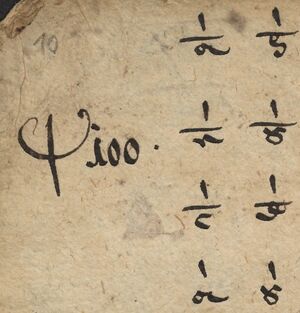
Ms. Lynar B 7 consists of single- and multi-verse settings of various Genevan psalms and the chorale Erhalt uns, Herr, bei deinem Wort.
This manuscript was published by Pieter Dirksen in 1996.
Description
The header of each piece is stylized by a three-pronged symbol followed by the number of the psalm. Some verses are also marked "3 voci" or "Corall in tenor" for example.
Contents
| fol. | Title | Incipit | Notes |
|---|---|---|---|
| 1r-2r | P 66 |  2. V.  |
|
| 2v-3r | P 5 |  2 Vari / in Basso  3 V. / im Tenor  |
|
| 3v-5r | P 116 |  2 Vari:  3. Vari / Corahll in / Tenor  4 Variatio / a 4  |
|
| 5v-7r | P 100 |  [2 V]  3 variation  [4 V]  |
Written in second hand |
| 6v-7r | Erhalt uns / Herr beij / deinen wortt |
 2 Variation 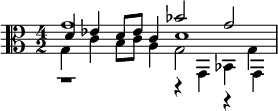 3 Variation 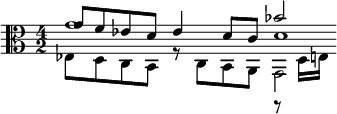 |
Written in second hand |
| 7v-8r | P 24 |  2 V. / a 3  |
Analysis
Dirksen states that the pieces in this manuscript can be conclusively connected with the Netherlands. While such psalm variations (and the psalm melodies themselves) are wholly unknown in Germany, they were abundantly found in the Netherlands, always in variation form (instead of German forms such as the Chorale Fantasia).
According to Dirksen, the five psalm melodies found in Ms. Lynar B 7 were the most popular melodies from the Genevan Psalter during this time period.
The psalm variations are marked by a great unity of style. On the other hand, the setting of Erhalt uns, Herr, bei deinem Wort is found to be slightly more sophisticated, and it has more rhythmic and harmonic variety. The compositions share a number of recurring musical patterns with pieces by Jan Pieterszoon Sweelinck, but the pieces are too conservative in character to have been composed by him. They were likely written by another composer who lived around the same time. They were probably brought to the German-speaking lands by a student of Sweelinck who copied them into tablature notation.
References
Dirksen, Pieter (editor). Psalm Variations from Lynar B 7. Exempla Musica Neerlandica XVIII. Utrecht: Koninklijke Vereniging voor Nederlandse Muziekgeschiedenis, 1996.
Lynar B 8
Seiffert: Ms. Lynar B 8 | Deutsche Orgeltabulatur ca. 1630. | darin der Siefertschüler Andreas | Neunaber vertreten
Ms. Lynar B 8. German organ tablature from around 1630, containing Andreas Neunhaber, the student of Siefert.
D-B Ms. Lynar B 8 Online facsimile: digital.staatsbibliothek-berlin.de accessed 3 November, 2023.
This manuscript contains two pieces, "Ich ruff zu / dir herr / Jesu Christ / auff 2. clavier" and "Alio modo / auff 2. und 3. / Clavir, und auff der / Pedal zu gebrauf [?] / Anton Neünhaber." These are thought to be two verses of the same piece by Andreas Neunhaber. The second piece is in five voices and has detailed manual change indications written into the tablature.
Contents


References
Beckmann, K. (editor). 3 Choralbearbeitunten von Anton Neunhaber und Ewald Hintz. Wiesbaden: Breitkopf & Härtel, 1974.
Lynar B 9
Seiffert: Ms. Lynar B 9 | Deutsche Orgeltabulatur ca. 1630 | 2 anonyme Praeludien.
Ms. Lynar B 9. German organ tablature from around 1630. Two anonymous preludes.
D-B Ms. Lynar B 9 Online facsimile: digital.staatsbibliothek-berlin.de accessed 3 November, 2023.
Lynar B 9 contains two preludes on two pages. The title page lists the keys/tonality "A cis" and "F a".
Contents



References
Lynar B 10
Seiffert: Ms. Lynar B 10 | Deutsche Orgeltabulatur ca. 1640. | Inhalt 1 anonyme Choralbearbeitung
Ms. Lynar B 10. German organ tablature from around 1640. Contains one anonymous choral work.
D-B Ms. Lynar B 10 Online facsimile: digital.staatsbibliothek-berlin.de accessed 3 November, 2023.
This manuscript contains one piece, anonymous Sei nun wieder zufrieden a 3. The composition ends after the first system on the third page, the final symbol is a cut time signature.
The texture of the piece is very odd compared to all the other pieces contained in the Lynar Tablatures. Actually, it appears that it is an intabulation of a cantata instead of an original organ piece (Scierning says that it seems to have been written for two sopranos and basso continuo).
The title is from Psalm 116, verse 7.
References
Scierning, 106
Lynar C
Lynar C contains anonymous polyphonic settings of the 150 genevan psalms (actually only 124 settings, because of the reuse of psalm tunes). It is written on 119 sheets in New German Tablature Notation.
The settings are extremely simple. It appears that this was a psalm-book that used privately by people gathered together, who would sing the psalms, or play them on all different instruments, at social gatherings (or it was a copy of this type of book).
The current status of Ms. Lynar C is not clear. It is not found in the [3] database under the shelfmark "Ms. Lynar C" or "Lynar B 11"[1]. Additionally, this manuscript seems to have recieved virtually no musicological attention besides mentions in collection with the other manuscripts.
References
Schierning, 106-109.